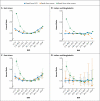Association between body-mass index and risk of death in more than 1 million Asians
- PMID: 21345101
- PMCID: PMC4008249
- DOI: 10.1056/NEJMoa1010679
Association between body-mass index and risk of death in more than 1 million Asians
Abstract
Background: Most studies that have evaluated the association between the body-mass index (BMI) and the risks of death from any cause and from specific causes have been conducted in populations of European origin.
Methods: We performed pooled analyses to evaluate the association between BMI and the risk of death among more than 1.1 million persons recruited in 19 cohorts in Asia. The analyses included approximately 120,700 deaths that occurred during a mean follow-up period of 9.2 years. Cox regression models were used to adjust for confounding factors.
Results: In the cohorts of East Asians, including Chinese, Japanese, and Koreans, the lowest risk of death was seen among persons with a BMI (the weight in kilograms divided by the square of the height in meters) in the range of 22.6 to 27.5. The risk was elevated among persons with BMI levels either higher or lower than that range--by a factor of up to 1.5 among those with a BMI of more than 35.0 and by a factor of 2.8 among those with a BMI of 15.0 or less. A similar U-shaped association was seen between BMI and the risks of death from cancer, from cardiovascular diseases, and from other causes. In the cohorts comprising Indians and Bangladeshis, the risks of death from any cause and from causes other than cancer or cardiovascular disease were increased among persons with a BMI of 20.0 or less, as compared with those with a BMI of 22.6 to 25.0, whereas there was no excess risk of either death from any cause or cause-specific death associated with a high BMI.
Conclusions: Underweight was associated with a substantially increased risk of death in all Asian populations. The excess risk of death associated with a high BMI, however, was seen among East Asians but not among Indians and Bangladeshis.
Figures


Comment in
-
Body-mass index and risk of death in Asians.N Engl J Med. 2011 Jun 2;364(22):2165-6; author reply 2166. doi: 10.1056/NEJMc1103451. N Engl J Med. 2011. PMID: 21631337 No abstract available.
-
Body-mass index and risk of death in Asians.N Engl J Med. 2011 Jun 2;364(22):2165; author reply 2166. doi: 10.1056/NEJMc1103451. N Engl J Med. 2011. PMID: 21631338 No abstract available.
References
-
- Abelson P, Kennedy D. The obesity epidemic. Science. 2004;304:1413. - PubMed
-
- Haslam DW, James WP. Obesity. Lancet. 2005;366:1197–209. - PubMed
-
- WHO Expert Consultation Appropriate body-mass index for Asian populations and its implications for policy and intervention strategies. Lancet. 2004;363:157–63. [Erratum, Lancet 2004;363:902.] - PubMed
-
- Brockwell SE, Gordon IR. A comparison of statistical methods for meta-analysis. Stat Med. 2001;20:825–40. - PubMed
-
- DerSimonian R, Laird N. Meta-analysis in clinical trials. Control Clin Trials. 1986;7:177–88. - PubMed
MeSH terms
Grants and funding
LinkOut - more resources
Full Text Sources
Other Literature Sources
Medical
